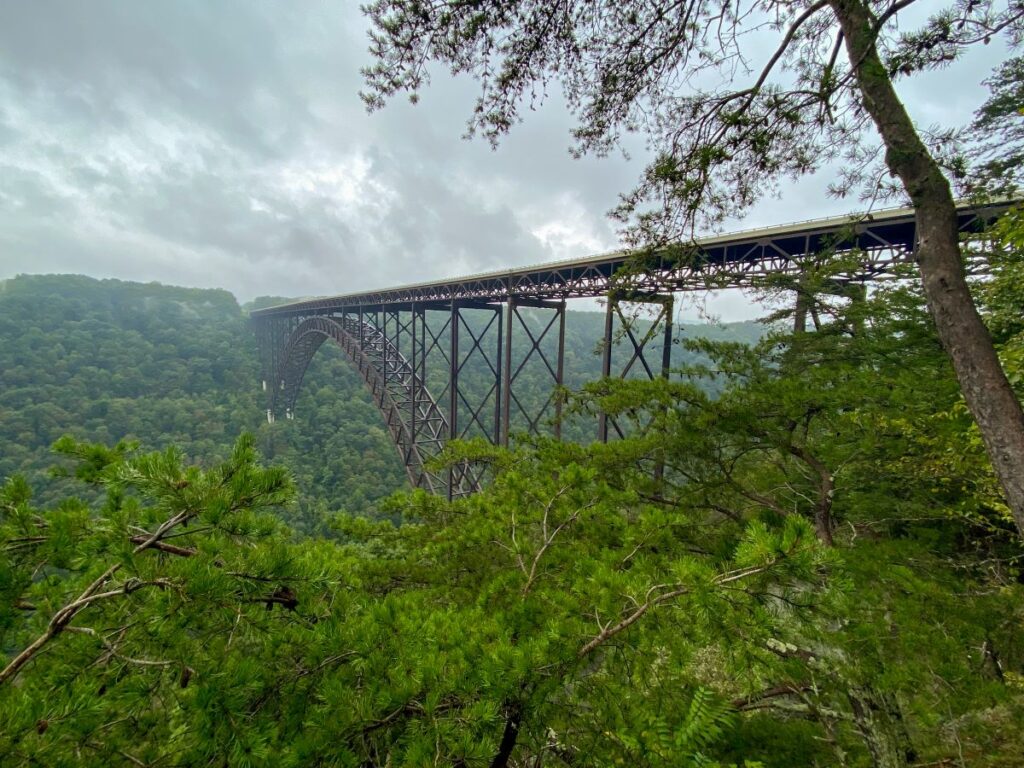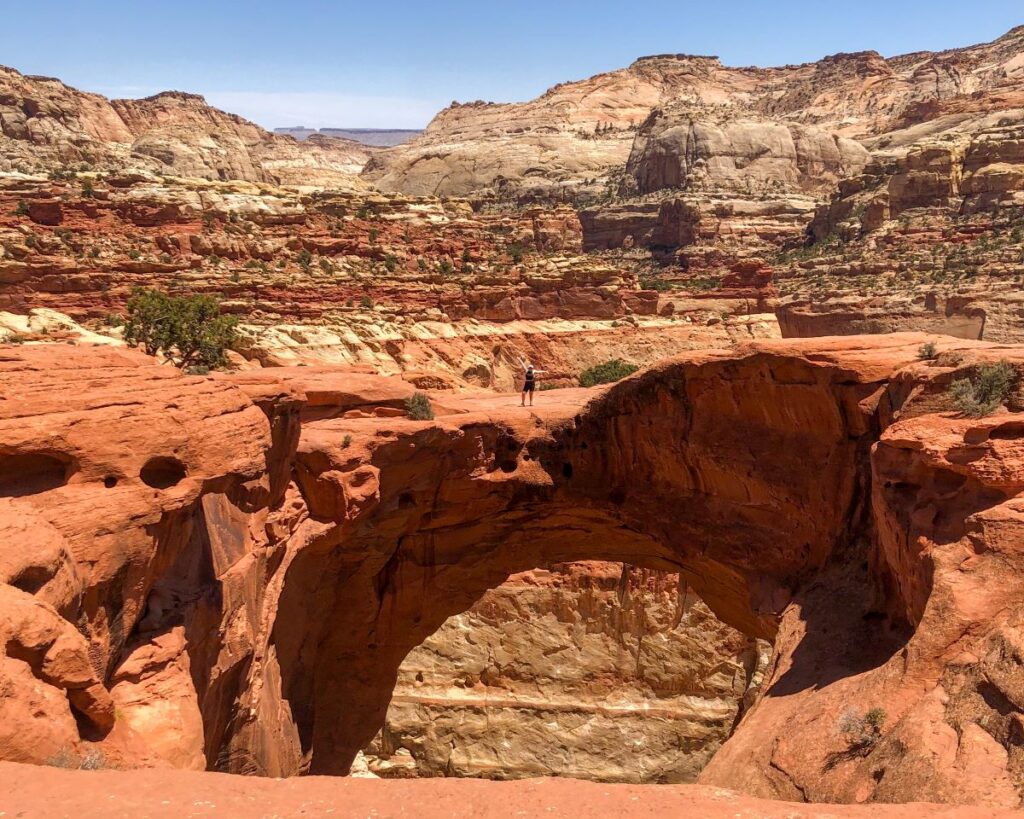The Grand Canyon of the Yellowstone is one of the most breathtaking and vast areas of the park. If you’re planning a trip to Yellowstone National Park, a visit to the Grand Canyon of the Yellowstone is a must.
You can experience the Grand Canyon of the Yellowstone through a series of viewpoints and short hikes off the north and south rims. The bright colors, deafening waterfalls, and stunning scenery will leave you speechless!
This post has everything you need to know about visiting the Grand Canyon of the Yellowstone, including the best viewpoints, where to stay, where to eat, and more!
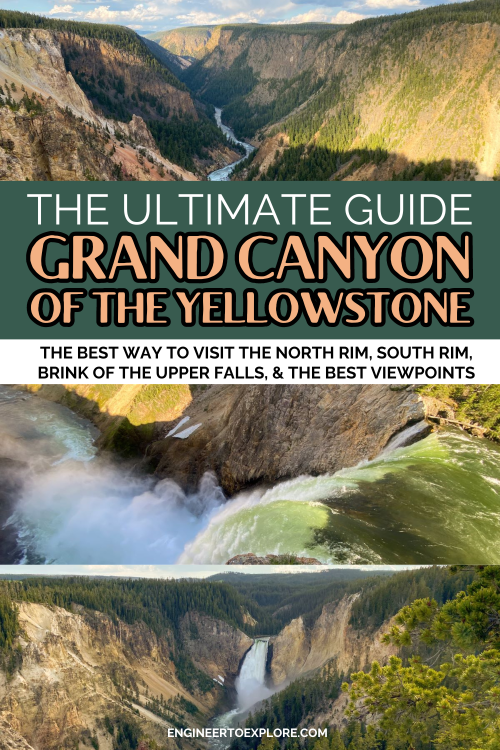
What’s So Special About the Grand Canyon of the Yellowstone?
The Grand Canyon of the Yellowstone is a 20-mile long canyon carved by the Yellowstone River. This area is unique because it is also home to geothermal activity (you’ll often see puffs of steam coming out of the canyon walls!).
Rhyolite, calcite, and iron compounds make up the bright colors you’ll see at various viewpoints along the north and south rims.
Scientists aren’t totally sure how the Grand Canyon of the Yellowstone was formed, but they do know that the canyon was formed by water erosion.
A combination of the Yellowstone Caldera erupting, massive lava flows carving out the landscape, and the Yellowstone river eroding the weak rock formed the canyon we see today!
2 of the 3 major waterfalls on the Yellowstone River are also located here, the Upper and Lower Falls (the third waterfall is Tower Fall, located 18 miles north off of Grand Loop Road).
The Lower Falls are the tallest of the 3, standing at over 300 feet high!
Related: The Ultimate Yellowstone Bucket List: Top 17 Things to See & Do
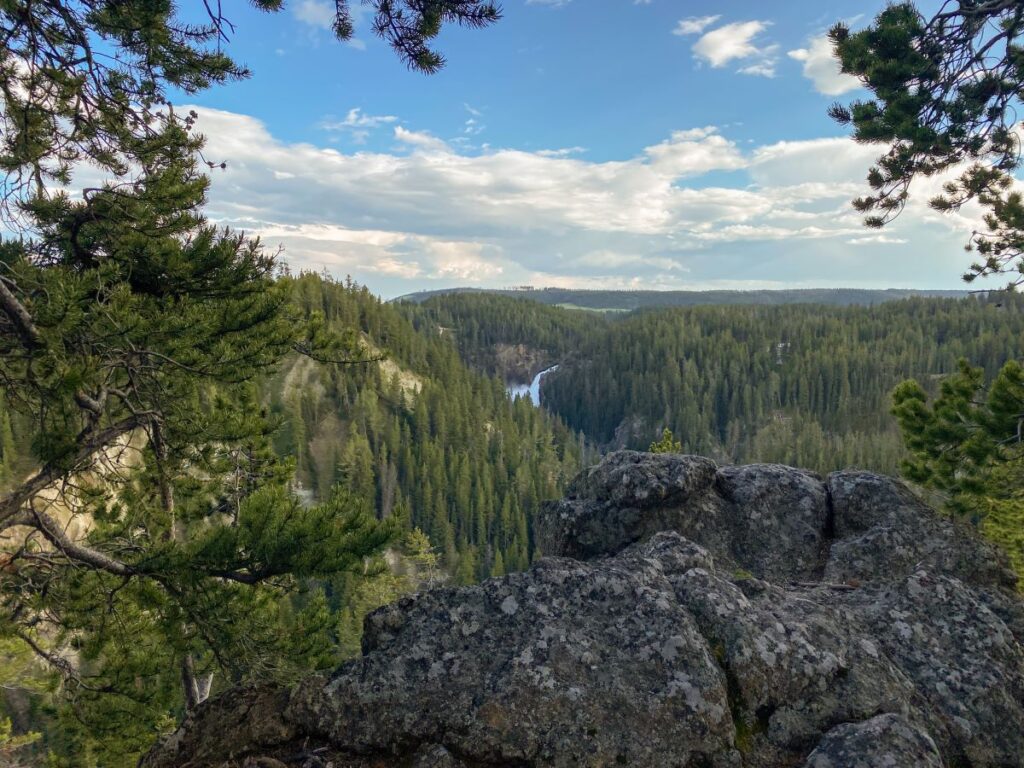
The Best Time to Visit the Grand Canyon of the Yellowstone
The best time to visit the Grand Canyon of the Yellowstone is in the summer between June and September. All of the Canyon Village amenities are closed between September and May due to snowfall.
Yes, crowds are large in the summer, but it is the only time you’ll be able to enjoy all that Yellowstone has to offer! Do most of your adventuring in the early morning and evening and you’ll be able to beat the crowds in peak season.
Related: The Ultimate 1-5 Day Yellowstone Itinerary
How Long Do You Need to Visit the Grand Canyon of the Yellowstone?
You’ll want to reserve a solid half-day if you want to explore all of the Grand Canyon of the Yellowstone. Spending 3-4 hours will give you enough time to drive to the viewpoints and do a couple short hikes.
If you want to do one or more of the longer hikes (a full list of hikes in the Grand Canyon of the Yellowstone is listed below), you’ll want to reserve a full day.
When is the Best Time of Day to Visit the Grand Canyon of the Yellowstone?
The best time of day to visit the Grand Canyon of the Yellowstone is in the morning or early evening. This is a busy area of the park, so avoiding the midday crowds will give you a better experience, easier parking, and better weather.
The morning light is best for photographing the canyon.

Grand Canyon of the Yellowstone Map & Viewpoints
The Grand Canyon of the Yellowstone is broken up into 3 major areas: the North Rim, the South Rim, and the Brink of the Upper Falls (technically on the North Rim but it has its own separate road and parking lot, so I’m listing it as a separate area).
The most efficient way to explore the viewpoints here is to drive to each one (there is parking at each viewpoint location).
You can hike the entire rim (both north and south separately or you can string them together) and stop at each viewpoint on the way, but this will take you a lot longer to do and isn’t worth it in my opinion.
Yellowstone is a huge park with a lot to explore, so you’ll want to be efficient with your time, especially if it is your first visit!
Some of the viewpoints are wheelchair-accessible overlooks, and some of them are short but strenuous hikes. Below is a description of each viewpoint to help you decide which ones are worth a stop on your trip.
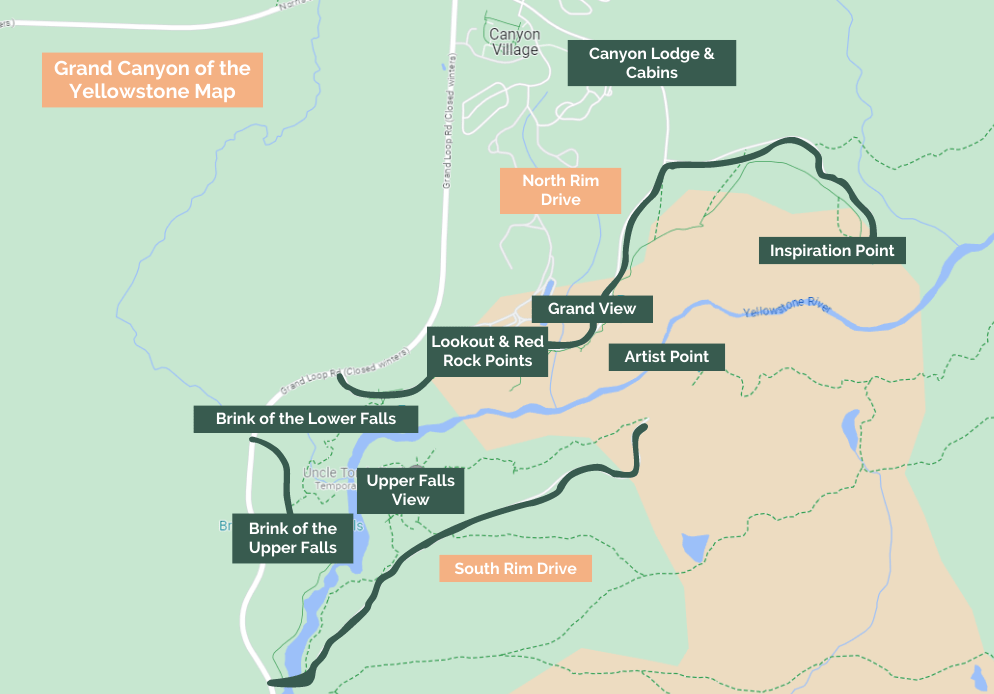
The North Rim of the Grand Canyon of the Yellowstone
Brink of the Lower Falls
0.8 miles / 600 feet of elevation gain
If you only have enough energy to do one of the hikes at the Grand Canyon of the Yellowstone, definitely do the Brink of the Lower Falls.
The Lower Falls stand 308 feet tall and you can get right up close to where the water drops off over the cliff at this viewpoint!
This trail will take you down some steep switchbacks to the brink of the falls. The waterfall sounds are deafening and the 300-foot drop down into the canyon is daunting and exhilarating!
Take your time coming back up this trail. The Brink of the Lower Falls sits at an elevation of 7700 feet, and climbing at this altitude is no joke!
We survived, (as 2 Midwesterners) and the climb back up really wasn’t too bad. The view was definitely worth it!
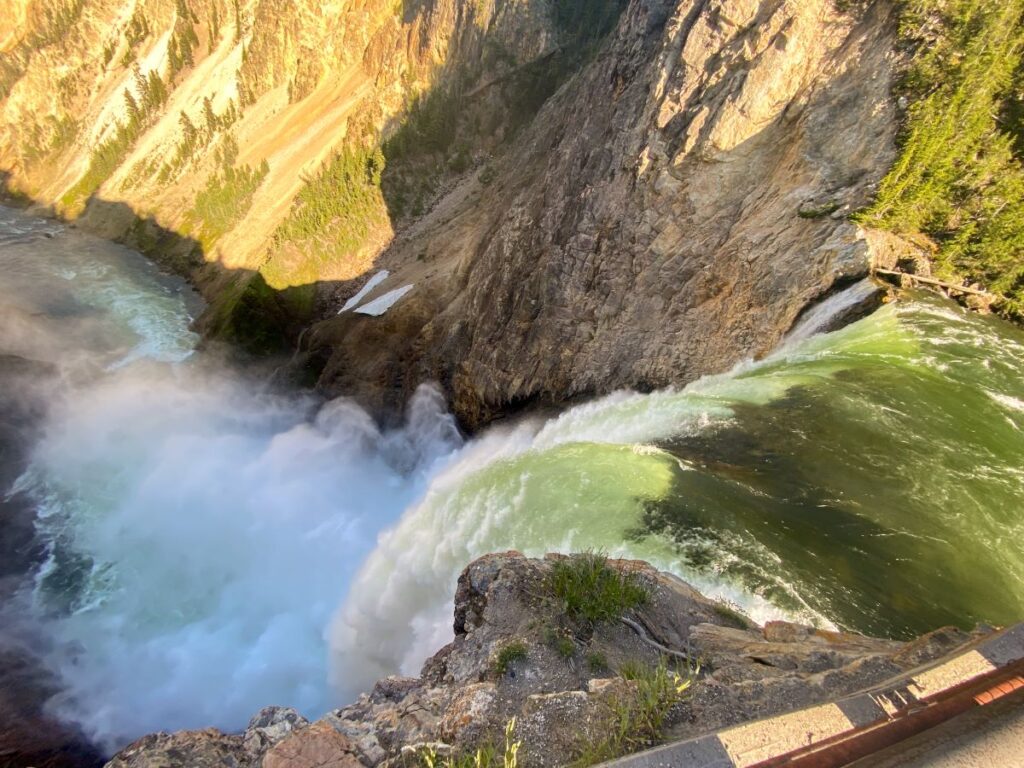
Yellowstone got record snowfall during the winter of 2022/2023, so all of the rivers and waterfalls were absolutely rushing with water.
Lookout Point
Overlook
This quick viewpoint has 13 steps down to a spectacular view of the Lower Falls.
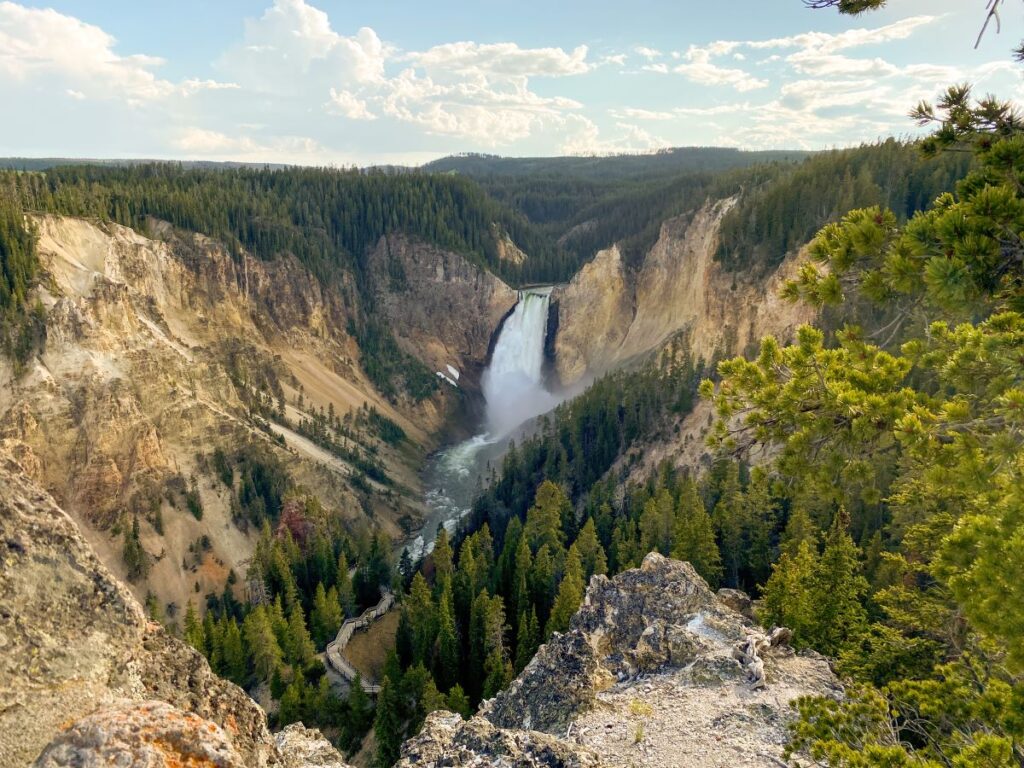
Red Rock Point
0.7 miles / 259 feet of elevation gain
Red Rock Point is another short but steep hike down to a view of the Grand Canyon of the Yellowstone.
This trailhead begins at Lookout Point. Follow the wooden stairs and paved path down to the viewpoint for one of the closest views of the Lower Falls. The red color at this viewpoint is from thermally-altered rhyolite and iron ore deposits in the rock.
Grand View
Overlook
The Grand View Overlook gives a colorful view of the Grand Canyon of the Yellowstone and the Yellowstone River.

Inspiration Point
Overlook
Inspiration Point is the last overlook on the North Rim of the Grand Canyon of the Yellowstone. It has a similar view to Grand View, but this view is much better!
Walk down the short step trail to expansive views down into the canyon.
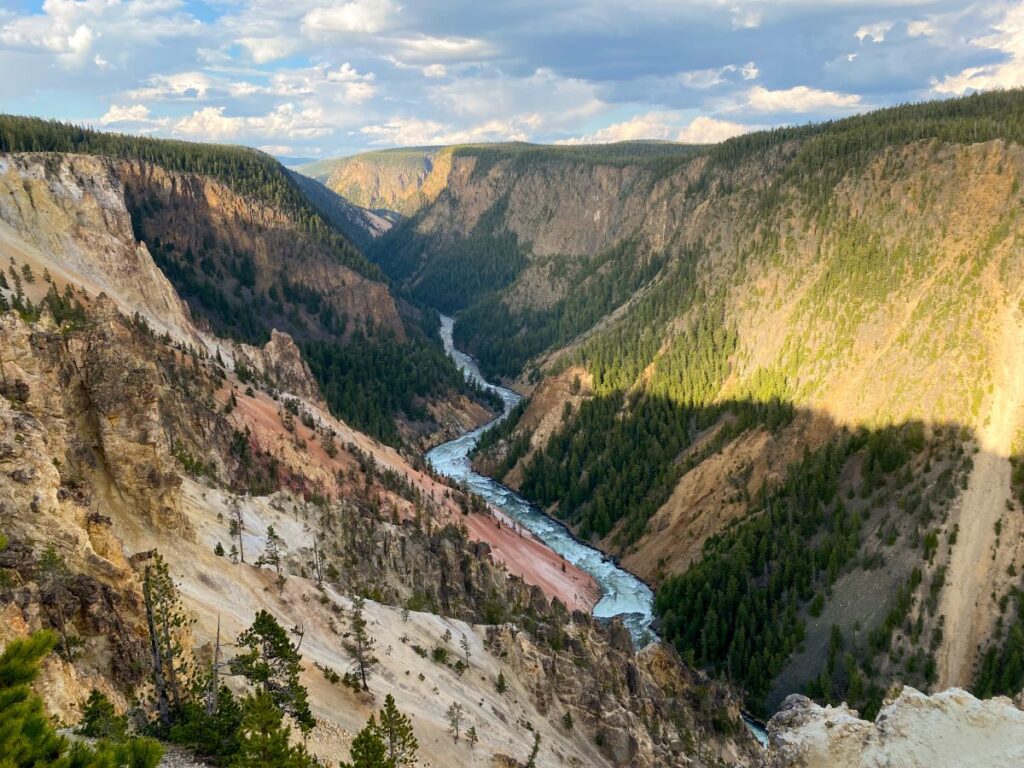
Brink of the Upper Falls
0.3 miles / 39 feet of elevation gain
The Brink of the Upper Falls is technically on the North Rim, but it isn’t connected to North Rim Drive and there is a separate parking lot. So I’m including it as a separate section here.
The Upper Falls is the other major waterfall to see at the Grand Canyon of the Yellowstone. It stands 110 feet tall and is located upstream of the Lower Falls (the Yellowstone River flows to the north).
Similar to the Brink of the Lower Falls, you can also do a short hike to the Brink of the Upper Falls.
Even though the Upper Falls aren’t as impressive as the Lower Falls, it’s still worth a stop here. The hike down and back is much easier and quicker!
We found this area less busy than other areas on the north and south rims, plus the parking lot is huge.
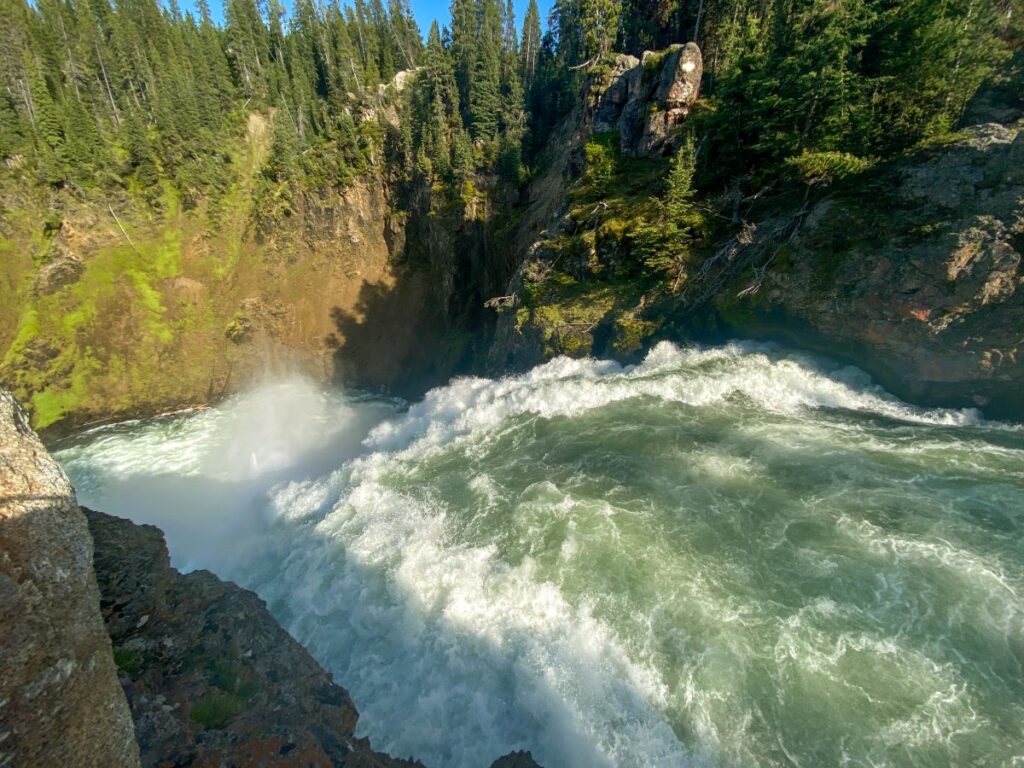
The South Rim of the Grand Canyon of the Yellowstone
Upper Falls View
The Upper Falls View is the first stop you’ll come to on the South Rim of the Grand Canyon of the Yellowstone.
This area gives a good close view of the Upper Falls. If you look to the right of the falls you will see people at the viewing platform at Brink of the Upper Falls!
There is also a paved 0.3-mile slightly downhill walk to another viewpoint directly across from the Upper Falls. We were a bit underwhelmed with this view, as it’s a bit obstructed.
If you see “Uncle Tom’s Point” on your maps, just note that this trail has been closed since 2019 with no plans to reopen.
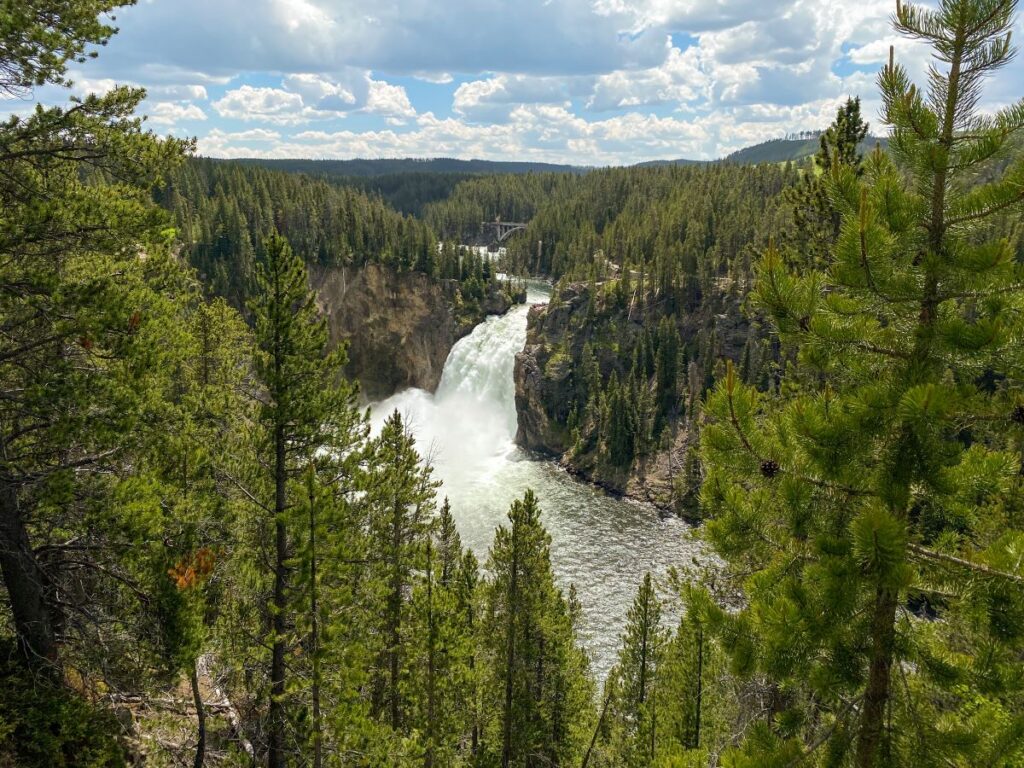
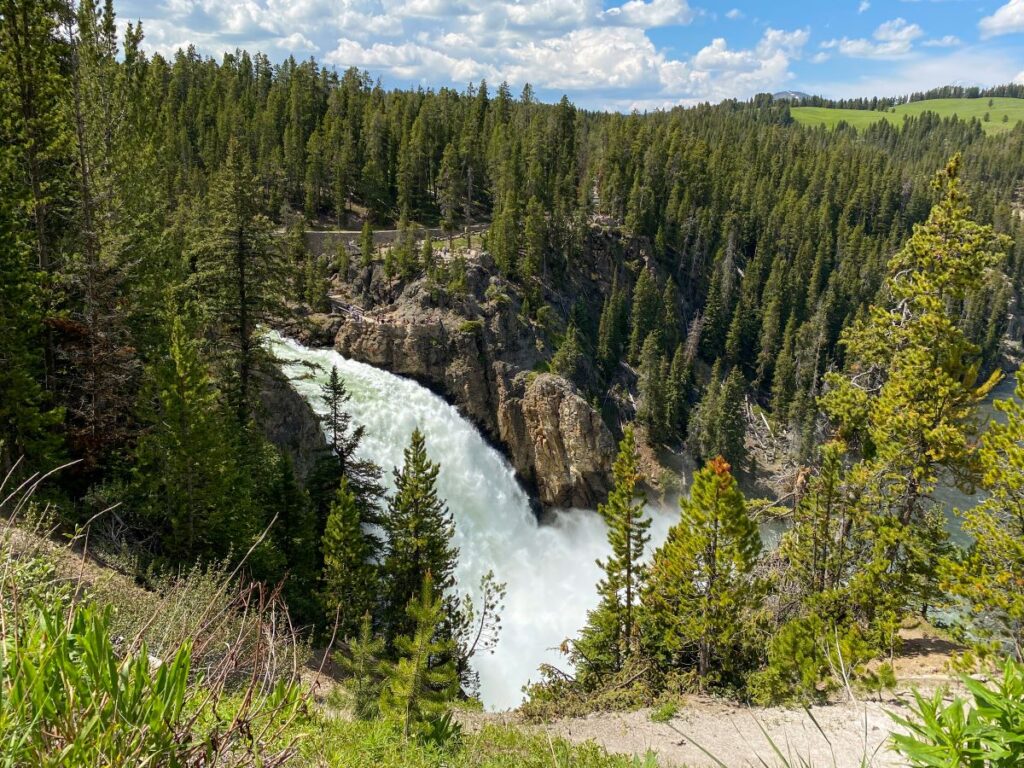
Artist Point
Artist Point is one of the most photographed places in Yellowstone National Park. This viewpoint has an absolutely outstanding view of the canyon and the Lower Falls in the distance.
This is also one of the busiest viewpoints in the park, so I’d recommend coming in the morning or evening. The morning will give the best light for photos here, so keep that in mind if you’re a photographer!
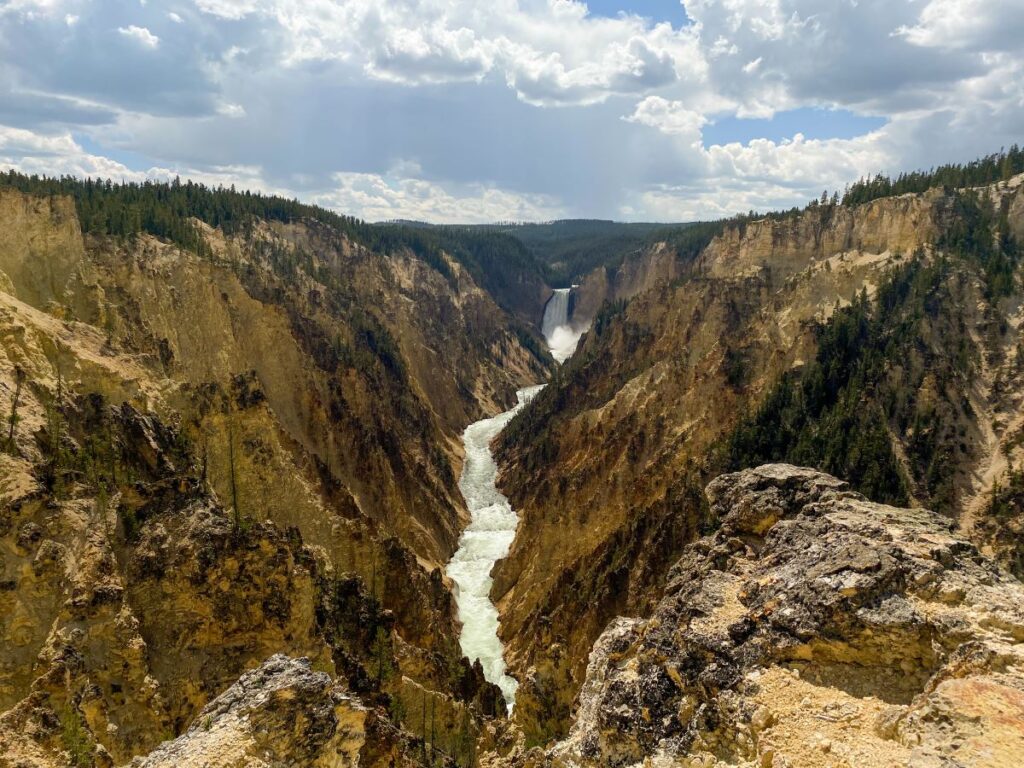
Grand Canyon of the Yellowstone Hikes
If you want to thoroughly explore the Grand Canyon of the Yellowstone, hiking is the best way. Here is a list of hikes in the area (including the short ones I mentioned above):
- Brink of the Lower Falls: 0.8-mile, moderately strenuous hike down to the Brink of the Lower Falls with 600 feet of elevation gain. Note, the elevation gain listed in this link is wrong, but the trail map is correct.
- Red Rock Point: 0.7-mile, short but steep hike to a great view of the Lower Falls and red rhyolite and iron ore rocks with 259 feet of elevation gain.
- Brink of the Upper Falls: 0.3-mile, easy, out-and-back hike to the Brink of the Upper Falls with 39 feet of elevation gain.
- North Rim Trail: 6.4-mile, moderately challenging, out-and-back hike along the North RIm with 675 feet of elevation gain.
- South Rim Trail: 2.5-mile, easy, out-and-back hike with 278 feet of elevation gain along the South Rim to Artist Point.
- Point Sublime: 2.7-mile, moderate, out-and-back hike starting from Artist Point with 341 feet of elevation gain.
- 7 Mile Hole Trail: 9.7-mile, challenging, out-and-back hike off the North Rim along the Yellowstone River with 2043 feet of elevation gain.
Where to Stay Near Grand Canyon of the Yellowstone
The best place to stay when visiting the Grand Canyon of the Yellowstone is at the Canyon Lodge and Cabins inside Canyon Village. There are over 500 rooms and it’s located inside Yellowstone National Park minutes away from the Grand Canyon of the Yellowstone.
The reservations are managed by Xanterra and sell out really fast, so it’s best to book six months to a year in advance.
Check availability for Canyon Lodge on the Xanterra website here.
We stayed 2 nights in a cabin here and had a good experience! You won’t have air conditioning (but you really don’t need it, even in the summer).
Tower, Lake, and Old Faithful can be good options as well if Canyon Lodge is booked up.
I would definitely recommend staying inside the park if you’re planning to visit the Grand Canyon of the Yellowstone. Staying outside the park will add hours to your driving time for the day and is much less convenient.
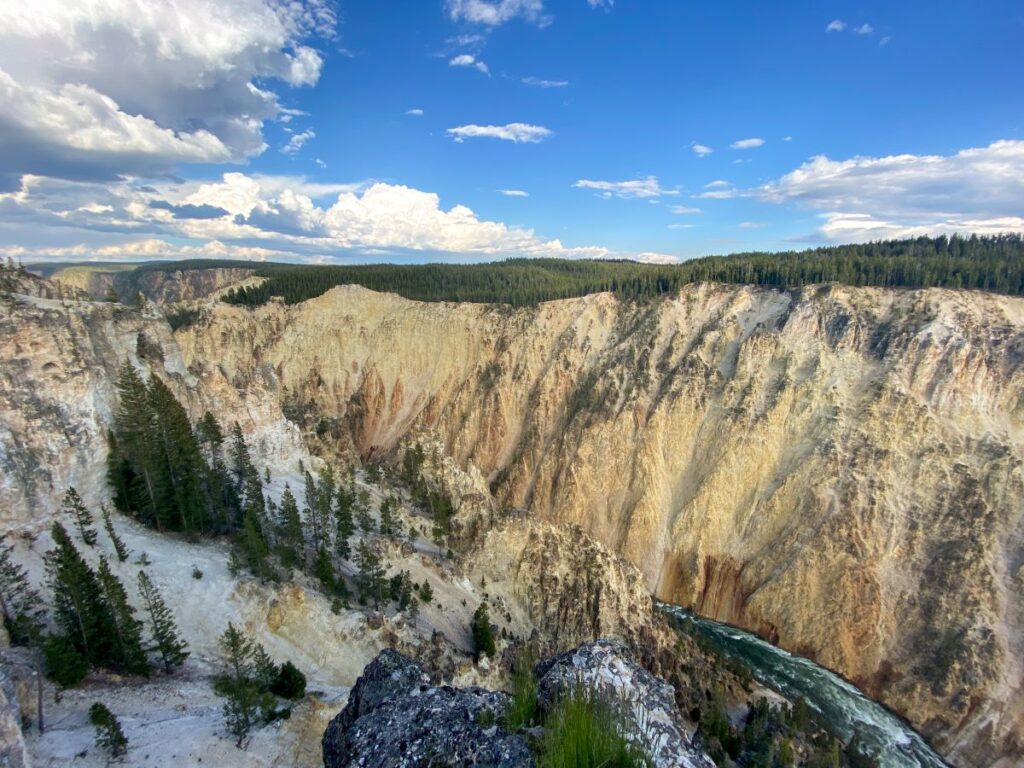
Where to Eat Near Grand Canyon of the Yellowstone
Canyon Village is by far the most convenient place to eat when visiting the Grand Canyon of the Yellowstone.
Unfortunately, leaving the park to eat just doesn’t make sense because the nearest town past the east entrance of Yellowstone, Cody, is 93 miles away from Canyon Village!
Here are the dining options in Canyon Village:
- Canyon Lodge Eatery: fast-casual, cafeteria-style dining
- Canyon Lodge Washburn Lookout: grab-and-go sandwiches, coffee, snacks
- Canyon Lodge Ice Creamery: Ice cream
- Canyon Lodge M66 Lounge: Drinks, appetizers
- Canyon Lodge Falls Cafe: Coffee, salads, grab-and-go sandwiches
Grand Canyon of the Yellowstone FAQs
What are the Best Things to Do at the Grand Canyon of the Yellowstone if You’re Short on Time?
If you’re short on time when visiting the Grand Canyon of the Yellowstone, I would recommend the Lookout Point and Inspiration Point Overlooks on the North Rim and the Upper Falls View and Artist Point overlooks on the South Rim.
If you have a little more time, I highly recommend hiking to Brink of the Lower Falls on the North Rim.
What is the Best Hiking Trail at the Grand Canyon of the Yellowstone?
The best short hikes at the Grand Canyon of the Yellowstone are Brink of the Lower Falls and Red Rock Point.
If you want to add on another moderate day hike, I would recommend the Point Sublime Trail.
I would skip the North and South Rim trails since you can drive to the best viewpoints.
Which is the Better: the Upper or Lower Falls in Yellowstone?
The Lower Falls at Yellowstone National Park are much taller and more impressive than the Upper Falls. The Lower Falls drop over 300 feet and the Upper Falls drop 110 feet.
Both waterfalls are great to experience, but the massive height of the Lower Falls are hard to beat!
Can You See the Grand Canyon of the Yellowstone Without Hiking?
Yes, you can see the Grand Canyon of the Yellowstone without hiking.
Lookout Point, Inspiration Point, and Grand View on the North Rim and Upper Falls View and Artist Point on the South Rim offer stunning views of the falls and the canyon without a long or strenuous hike.
Where is the Best Place to See the Lower Falls in Yellowstone?
The best place to see the Lower Falls in Yellowstone is at Lookout Point and Red Rock Point. Lookout Point is a short walk to an overlook and Red Rock Point is a short, but moderately strenuous hike.
Another amazing way to experience the Lower Falls is hiking to Brink of the Lower Falls. You’ll be up close and personal to the 300-foot cliff to fully experience the power of the waterfall.
Where is the Best Place to See the Upper Falls in Yellowstone?
The best place to see the Upper Falls in Yellowstone is the Upper Falls View viewpoint. If you want to get up close to the Upper Falls, hike the short, downhill trail at Brink of the Upper Falls.
Is the North or South Rim of the Grand Canyon of the Yellowstone Better?
The North Rim of the Grand Canyon of the Yellowstone has more opportunities to view the impressive Lower Falls, so I would give the North Rim a slight edge over the South Rim.
The Brink of the Lower Falls Trail also gives the North Rim an edge over the South Rim. The deafening sounds, massive drop off, and mist from the water is truly incredible and needs to be experienced!
However, Artist Point on the South Rim is truly iconic and makes a tough choice between the North and South Rims. I highly recommend exploring both!

Do you plan to visit the Grand Canyon of the Yellowstone? Which viewpoint are you most excited for? Let me know in the comments below!
-Megan
If You Have More Time in Yellowstone National Park
Check out my other posts on Yellowstone to help you make the most of your visit!
- The Ultimate 1-5 Day Yellowstone Itinerary
- Yellowstone in One Day: 7 Best Yellowstone Road Trip Itineraries
- The Ultimate Yellowstone Bucket List: Top 17 Things to See & Do
- The Ultimate 9-Day Yellowstone and Grand Teton Road Trip Itinerary (+ Maps, Photos, & More!)
- The Complete Guide to All 5 Yellowstone Entrances
- Visiting the Old Faithful Area of Yellowstone (How to Beat the Crowds, Tips, & More!)
- Yellowstone National Park North Entrance: A Complete Guide
- All 11 Geyser Basins in Yellowstone Ranked
- 12 Essential Tips for Visiting Yellowstone in the Summer
- Beartooth Highway Scenic Drive Guide (With Tips & Photos!)

